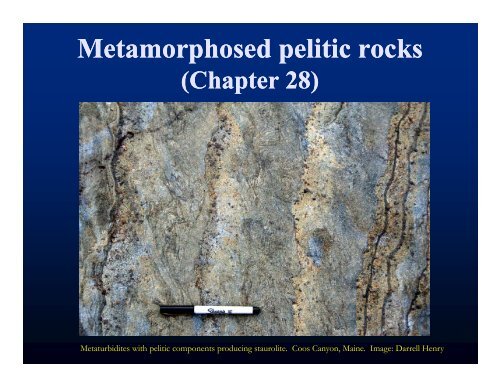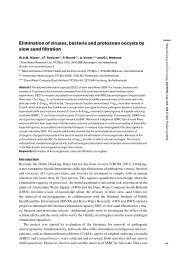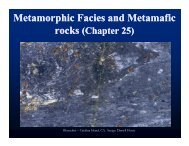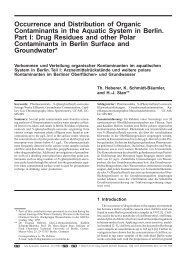28-Metapelites
28-Metapelites
28-Metapelites
- No tags were found...
Create successful ePaper yourself
Turn your PDF publications into a flip-book with our unique Google optimized e-Paper software.
Metamorphosed pelitic rocks(Chapter <strong>28</strong>)Metaturbidites with pelitic components producing staurolite. Coos Canyon, Maine. Image: Darrell Henry
Metamorphism of Pelitic Sedimentshttp://honoluluweekly.com/wpcontent/031506mud.jpg• Mudstones and shales: very fine grainedmature clastic sediments derived fromcontinental crust• Characteristically accumulate in distalportions of wedge of sediment offcontinental shelf/slope• Grade into coarser graywackes and sandysediments toward continental source• Although begins as mud, metapelitesrepresent a distinguished family ofmetamorphic rocks, because clays are verysensitive to variations in T and P, undergoingextensive changes in mineralogy duringprogressive metamorphism
Metamorphism of Pelitic Sediments• Mineralogy of pelitic sediments isTable <strong>28</strong>-1. Chemical Compositions* of Shalesand <strong>Metapelites</strong>1 2 3 4 5SiO 2 64.7 64.0 61.5 65.9 56.3TiO 2 0.80 0.81 0.87 0.92 1.05Al 2O 3 17.0 18.1 18.6 19.1 20.2MgO 2.82 2.85 3.81 2.30 3.23FeO 5.69 7.03 10.0 6.86 8.38MnO 025 0.25 010 0.10 018 0.18CaO 3.50 1.54 0.81 0.17 1.59Na2O 1.13 1.64 1.46 0.85 1.86K2O 3.96 3.86 3.02 3.88 4.15P2O5 0.15 0.15Total 100.00 100.08 100.07 99.98 96.94* Reported on a volatile-free basis (normalized to 100%) to aid comparison.1. "North American Shale Composite". Gromet et al. (1984). 2. Average of~100 published shale and slate analyses (Ague, 1991). 3. Ave. pelitepelagicclay (Carmichael, 1989). 4. Ave. of low-grade pelitic rocks, LittletonFm, N.H. (Shaw, 1956). 5. Ave. ofdominated by fine Al-K-richphyllosilicates, such as clays, finewhite micas and chlorite, all ofwhich may occur as detrital orauthigenic grains• Fine quartz constitutes another 10-30%• Other common constituents includefeldspars (albite and K-feldspar), ironoxides and hydroxides, zeolites,carbonates, sulfides, and organicmatter• High Al 2 O 3 and K 2 O, and low CaO –modeled by KFMASH system
Metamorphism of Pelitic Sediments
Greenschist facies – biotite zone (AKF)Biotite-in in isograd – tie-line flip
Greenschist facies – biotite zone (AFM)Biotite-in in isograd – tie-line flipAFM projection for the biotitezone, greenschist facies, abovethe chloritoid isograd.AFM projection for theupper biotite zone,greenschist facies.
Greenschist facies – garnet zone (AFM)AFM projection for the garnet zone,transitional to the amphibolite facies,showing the tie-line flip associated withreaction
Amphibolite facies – staurolite zoneAFM projection in the staurolite zoneof the amphibolite facies – chloritoid-out isograd.AFM projection in the lowerstaurolite zone of the amphibolitefacies – St-chl isograd
Amphibolite facies – staurolite zoneAFM projection in the staurolite zone of the amphibolite facies – St-btisograd (tie-line flip)
Amphibolite facies – staurolite zoneExpanded view of Grt-St-Chl-Bt quadrilateral from illustrating tie-line flip ofdiscontinuous reaction (<strong>28</strong>-9) and progress of continuous reaction (<strong>28</strong>-10).a. At isograd tie-line flip. Composition Y loses Grt and gains St.b. As reaction (<strong>28</strong>-10) proceeds, the most Fe-rich chlorite breaks down andthe Chl-Grt-Bt triangle shifts to right.c. Further shift of Chl-Grt-Bt triangle due to reaction (<strong>28</strong>-10). Rocks ofcomposition Y lose chlorite at this grade, and staurolite develops in rocks ofcomposition Z.
Amphibolite facies – kyanite andsillimanite it zonesAFM projection for the kyanitezone, amphibolite facies – ky-btzone (tie-line flip)AFM projection above thesillimanite and "staurolite-out"isograds, sillimanite zone, upperamphibolite facies.
Granulite facies – cordierite zonesQuicktime i movie of 6kb kbar AFMAFM diagram (projected from K-fld feldspar) above the cordierite-init iisograds, granulite facies.
Low pressure metamorphismAFM diagrams (projectedfrom muscovite) for lowP/T metamorphism ofpelites.a. Cordierite formsbetween andalusite andchlorite along Mg-rich sideof the diagram via reaction(<strong>28</strong>-23) in the albite-epidote hornfels facies.b. Compositional range ofchloritoid is reduced andcordierite expands as Chl-Cld-And and And-Chl-Crdsub-triangles migratetoward more Fe-rich ihcompositions.
Low pressure metamorphismAFM diagrams (projectedfrom muscovite) for lowP/T metamorphism ofpelites.c. Cordierite is introducedto many Al-rich pelites viareaction (<strong>28</strong>-24) in thelowermost hornblendehornfels facies.(d) Chlorite is lost in Msbearinggpelites as a resultof reaction (<strong>28</strong>-25).Quick time movie ofQ3 kbar AFM
Stability of staurolite (limited)
Low pressure metamorphismAFM diagrams (projected from Kfs) in the lowermost pyroxene hornfels facies.a. The compositional range of cordierite is reduced as the Crd-And-Bt sub-triangle migrates toward more Mg-rich compositions. Andalusite may beintroduced into Al-rich pelitesb. Garnet is introduced to many Al-rich pelites via reaction (<strong>28</strong>-27).
High-temperature petrogenetic gridlocation of selected melting and dehydration equilibria in the NKFMASHsystem, with sufficient sodium to stabilize albite. Also shown are some equilibriain the KFASH (orange) and KMASH (blue) systems.
MigmatitesVeins developed in pelitic hornfelses within a few meters of the contact withdiorite.
MigmatitesSome textures of migmatites.a. Breccia structure inagmatite.b. Net-like structure.c. Raft-like structure.d. Vein structure.e. Stromatic, or layered,structure.f. Dilation structure in aboudinaged layer.g. Schleiren structure.h. Nebulitic structure.
MigmatiteComplex migmatite textures including multiple generations of concordant bandsand cross-cutting veins. Angmagssalik area, E. Greenland.
High-pressure metamorphismAFM diagrams (projected from muscovite) for the eclogite facies of high P/Tmetamorphism of pelites.a. Talc forms between nbiotite and chlorite along the Mg-rich side of thediagram via reaction (<strong>28</strong>-35).b. At higher grade Chl-Bt tie-line flips to Tlc-Cld tie-line via reaction (<strong>28</strong>-36).c. After chlorite breaks down the kyanite forms in many metapelites viareaction (<strong>28</strong>-36).









![21-IntroductionMetamorphism [Compatibility Mode].pdf](https://img.yumpu.com/32952021/1/190x146/21-introductionmetamorphism-compatibility-modepdf.jpg?quality=85)


